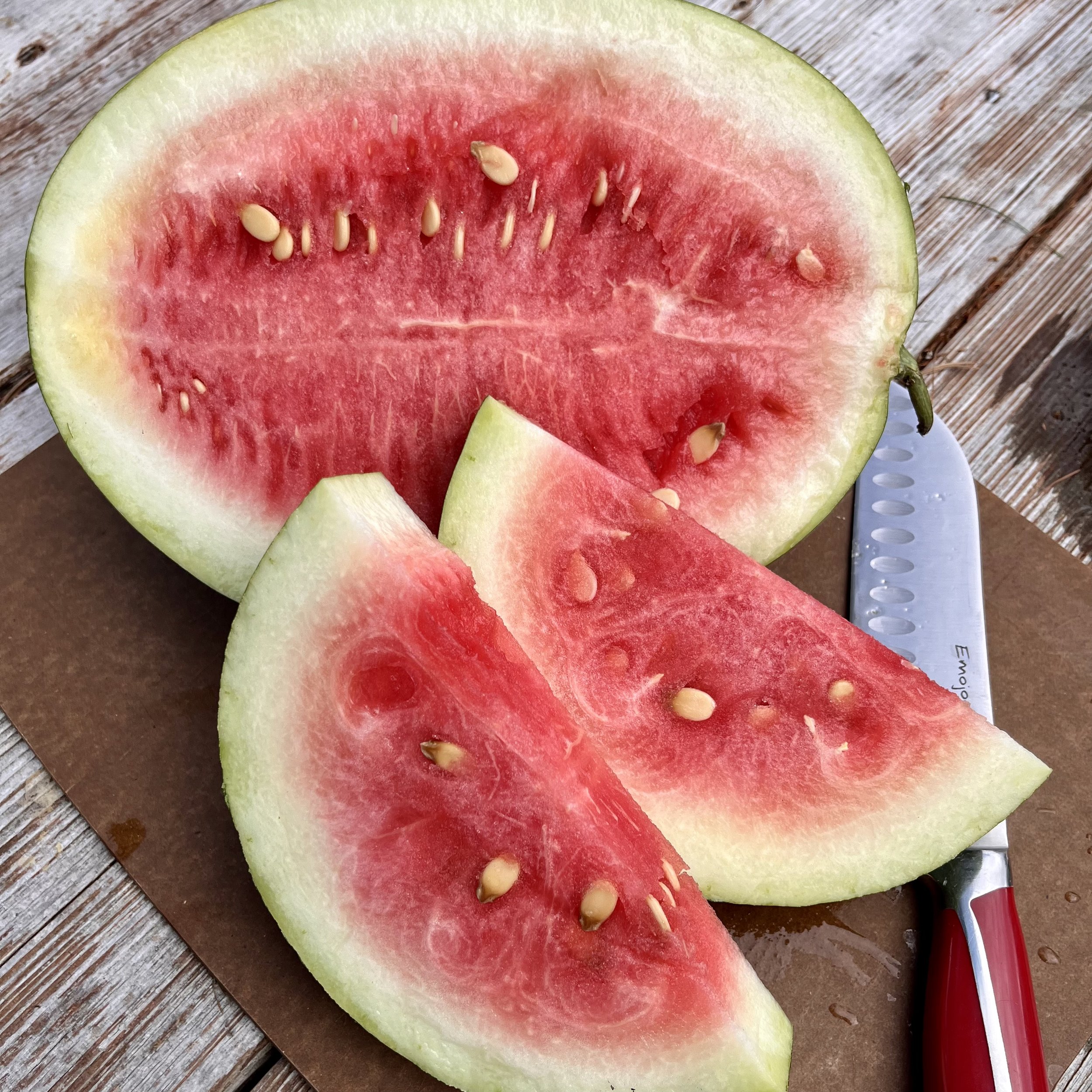Watermelon, Bradford
Product Description: (Citrullus vulgaris) The famed Bradford watermelon – a variety so distinctly sweet that the very pursuit of obtaining one proved deadly for many who attempted it.
In 1783, the Revolutionary War soldier John Lawson found himself aboard a British prison ship eating an unusually flavorful slice of watermelon and when he eventually returned home to Georgia, the seeds from that slice came with him. Growing these melons quickly became a lucrative business for Lawson, as his new variety earned a reputation for being the very best on the market. Lawson knew that each generation of plants had to be grown in strict isolation to assure genetic purity and a man named Nathaniel Bradford was one of just two individuals trusted with this task.
With time, the descendant “Bradford” variety went on to claim the throne that Lawson’s once held. Every marketgoer wanted to buy one and every farmer wanted to sell them. Those who did were plagued by theives looting fields in the night for the valuable seeds. Some growers would hire armed guards to protect their crop while others resorted to poisoning a few fruit as a signal to unwanted visitors that any melon they take could be their last. In the words of food historian David Shields, “there were more people killed in watermelon patches than in any other part of the agricultural landscape of America” with the sole exception of cattle rustlers.
The Southern economy struggled greatly post-Civil War and watermelon farmers were forced to sell their fruit in the North. Bradford watermelons, despite their unparalleled flavor, had rinds much too thin to for long haul transportation and by the early 1900s, the variety was believed extinct.
Nathaniel Bradford’s descendants eventually forgot just how impactful their family heirloom was on America’s agricultural history but they did keep it alive (and the seeds are much easier to get your hands on nowadays)! Open-pollinated. 15 seeds per packet (poison not included).
Growing Information: Sow outdoors in late spring once the soil temperature reaches 70°F or start indoors 3 weeks before your expected last frost date. 2-3 cm seed depth. Full sun required. 85 days to maturity.
How To Save Watermelon Seeds
Remove the seeds from your ripest fruit, discarding any that are damaged or underdeveloped. Rinse thoroughly and spread out on an open surface to fully dry.
Product Description: (Citrullus vulgaris) The famed Bradford watermelon – a variety so distinctly sweet that the very pursuit of obtaining one proved deadly for many who attempted it.
In 1783, the Revolutionary War soldier John Lawson found himself aboard a British prison ship eating an unusually flavorful slice of watermelon and when he eventually returned home to Georgia, the seeds from that slice came with him. Growing these melons quickly became a lucrative business for Lawson, as his new variety earned a reputation for being the very best on the market. Lawson knew that each generation of plants had to be grown in strict isolation to assure genetic purity and a man named Nathaniel Bradford was one of just two individuals trusted with this task.
With time, the descendant “Bradford” variety went on to claim the throne that Lawson’s once held. Every marketgoer wanted to buy one and every farmer wanted to sell them. Those who did were plagued by theives looting fields in the night for the valuable seeds. Some growers would hire armed guards to protect their crop while others resorted to poisoning a few fruit as a signal to unwanted visitors that any melon they take could be their last. In the words of food historian David Shields, “there were more people killed in watermelon patches than in any other part of the agricultural landscape of America” with the sole exception of cattle rustlers.
The Southern economy struggled greatly post-Civil War and watermelon farmers were forced to sell their fruit in the North. Bradford watermelons, despite their unparalleled flavor, had rinds much too thin to for long haul transportation and by the early 1900s, the variety was believed extinct.
Nathaniel Bradford’s descendants eventually forgot just how impactful their family heirloom was on America’s agricultural history but they did keep it alive (and the seeds are much easier to get your hands on nowadays)! Open-pollinated. 15 seeds per packet (poison not included).
Growing Information: Sow outdoors in late spring once the soil temperature reaches 70°F or start indoors 3 weeks before your expected last frost date. 2-3 cm seed depth. Full sun required. 85 days to maturity.
How To Save Watermelon Seeds
Remove the seeds from your ripest fruit, discarding any that are damaged or underdeveloped. Rinse thoroughly and spread out on an open surface to fully dry.
Product Description: (Citrullus vulgaris) The famed Bradford watermelon – a variety so distinctly sweet that the very pursuit of obtaining one proved deadly for many who attempted it.
In 1783, the Revolutionary War soldier John Lawson found himself aboard a British prison ship eating an unusually flavorful slice of watermelon and when he eventually returned home to Georgia, the seeds from that slice came with him. Growing these melons quickly became a lucrative business for Lawson, as his new variety earned a reputation for being the very best on the market. Lawson knew that each generation of plants had to be grown in strict isolation to assure genetic purity and a man named Nathaniel Bradford was one of just two individuals trusted with this task.
With time, the descendant “Bradford” variety went on to claim the throne that Lawson’s once held. Every marketgoer wanted to buy one and every farmer wanted to sell them. Those who did were plagued by theives looting fields in the night for the valuable seeds. Some growers would hire armed guards to protect their crop while others resorted to poisoning a few fruit as a signal to unwanted visitors that any melon they take could be their last. In the words of food historian David Shields, “there were more people killed in watermelon patches than in any other part of the agricultural landscape of America” with the sole exception of cattle rustlers.
The Southern economy struggled greatly post-Civil War and watermelon farmers were forced to sell their fruit in the North. Bradford watermelons, despite their unparalleled flavor, had rinds much too thin to for long haul transportation and by the early 1900s, the variety was believed extinct.
Nathaniel Bradford’s descendants eventually forgot just how impactful their family heirloom was on America’s agricultural history but they did keep it alive (and the seeds are much easier to get your hands on nowadays)! Open-pollinated. 15 seeds per packet (poison not included).
Growing Information: Sow outdoors in late spring once the soil temperature reaches 70°F or start indoors 3 weeks before your expected last frost date. 2-3 cm seed depth. Full sun required. 85 days to maturity.
How To Save Watermelon Seeds
Remove the seeds from your ripest fruit, discarding any that are damaged or underdeveloped. Rinse thoroughly and spread out on an open surface to fully dry.







